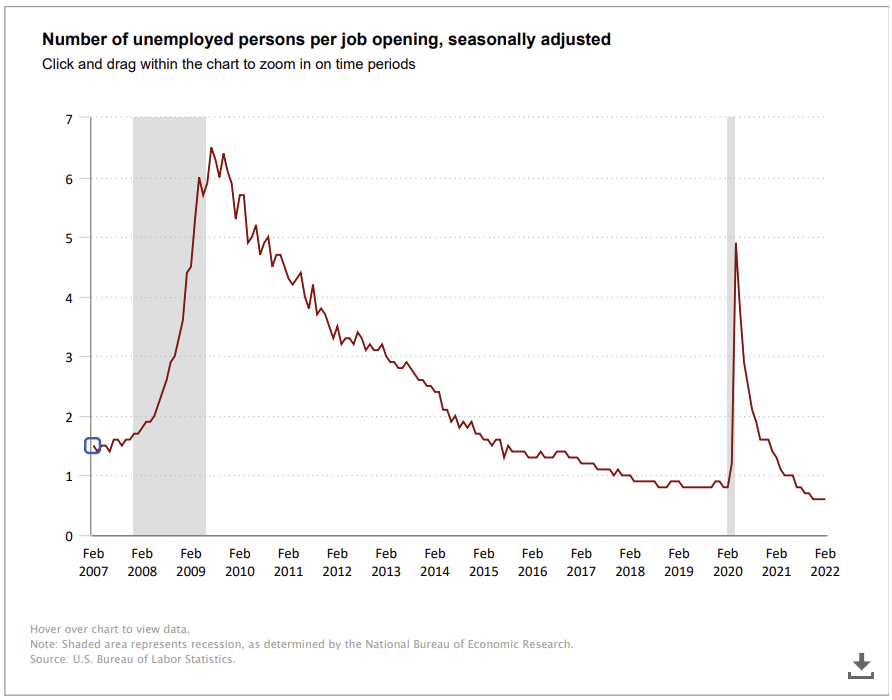A Battle for Talent Is Reshaping the Job Market

By Julie Norwell
Do you know what the number one priority is for CEOs in the United States this year? It’s a bit of an eye-opener. Despite the persistence of Covid-19 disruptions, rising inflation, the threat of war with Russia, and a looming climate crisis, the biggest concern of CEOs this year is…attracting and retaining talent.
That is the finding of the Conference Board, a global, independent research association in its C-Suite Outlook 2022. The report documents the results of a survey of 1,600 C-suite executives, including 917 CEOs, across the globe.
This fact says a lot about how far we’ve come since the onset of the pandemic. The past two years have been a rollercoaster ride for businesses, and especially for workers. In the early months of 2020, tens of millions of people hit the unemployment rolls in the space of weeks. The unemployment rate rocketed from one of the lowest it had ever been (3.5%) to one of the highest it had ever been (14.7%).
In fits and starts, the economy has recovered much lost ground. It isn’t the same economy, though. One ironic development is that job creation has outstripped the availability of workers. The labor pool is now running dry.
Although the Bureau of Labor Statistics reported 11.3 million job openings in February, 60% more than in February 2020, just six workers were available for every ten open jobs. (See chart.) The unemployment rate has plunged back to 3.6%.

For the foreseeable future, it’s a job seeker’s market. Employers know it, and they are doing everything they can to find talented individuals for their organizations and keep them there. If you’re unhappy in your work, or if you’re looking to advance your career, now is the time to make a change.
Where Have All the Workers Gone?
The labor market was tight before the pandemic. But not like this. People are quitting their jobs in record numbers, in a phenomenon called the Great Resignation. Many of them are re-evaluating what they want from work and opting for jobs with different working conditions or higher pay, as the market pushes wages up. Others have completely left the workforce.
The labor force participation rate – that is, the proportion of people 16 and older that is working or looking for work – while improving, is near historic lows at 62.4%. That’s an “unhealthy level” according to Jerome H. Powell, the Federal Reserve chair.
“By many measures, the labor market is extremely tight, significantly tighter than the very strong job market just before the pandemic. There are far more job openings going unfulfilled today than before the pandemic,” said Powell in a recent speech.
Where have all the workers gone?
An analysis from the Federal Reserve Bank of St. Louis spotlights two primary explanations.
Retirement – About half of the shortfall in the labor force participation is due to early retirements during the pandemic. The American labor landscape has long been expected to gradually shrink as baby boomers, the largest generation ever, reached retirement. The pandemic just accelerated the trend.
Taking Care of Family/Home – The proportion of people who stay home to care for family had been declining for years. But it shot up during the pandemic when people abruptly left the workforce to oversee children in remote schooling or attend to sick family members. It remains well above where it would have been if not for the pandemic.
Spice Up Your (Work) Life
In the face of labor shortages, employers are going to battle for talent. They know they will have to get creative, not just to attract and retain workers in the market, but also to lure retirees and parents that are now on the sidelines back into the workforce.
“Our job is to convince those who have stopped looking to come back to work,” said Jeanne J. Sutton, a financial benefits advisor at Bowling Green, KY-based consultancy, Strategic Retirement Partners. Sutton spoke recently at the SHRM Talent Conference & Expo 2022. She advises employers to think outside the box about what employees actually want, then to “spice up your benefits package and provide a truly unique recruiting tool.”
What might a “spiced up” package look like? More pay, absolutely. But high pay isn’t enough. Nor are the tried-and-true employee benefits, like health insurance, paid time off, hiring bonuses, and retirement savings plans. Employees want to feel that employers are investing in their lives and job satisfaction as much as employees invest themselves in their companies.
Human resource consulting firm, Robert Half, identifies the top six “perks” employees most want at work.
- Flexible work schedules – People want more control over their schedule.
- Remote work options – There is no putting this genie back in its bottle. The option to work remotely, at least part of the time, is now a must-have for most workers.
- Employee discounts – Company-exclusive discounts on purchases was a preferred perk for 37% of survey respondents. (Who knew?)
- Paid parental leave – Family-friendly benefits go a long way towards attracting talented people, especially women, whose career goals conflict with the demands of parenting.
- Company-subsidized meals or snacks – Communal snacks not only help employees refuel, they also encourage opportunities for building work relationships, which suffered during the pandemic.
- PTO for volunteering – Increasing numbers of the workforce are motivated by socially conscious endeavors and value the same in their employer.
Those perks are by no means exhaustive. Employers are exploring even more creative options, too:
- Stock options
- Career development programs
- Internal mobility programs
- Transitional retirements (Allowing older employees to work a partial schedule)
- Student debt assistance
- Four-day workweeks
- Wellness programs
- Guaranteed maximum workload
- Start-up-like recreation lounges
Companies that are willing to research what their employees want, and invest in employee satisfaction, are the companies that will win the battle for talent.
Find the Right Match for You
Yes, it’s a job seeker’s market, but finding the company that has the right blend of opportunity, compensation, benefits, and culture for you could still be challenging. If you’re going to make a change, you want to make sure it’s for the right job.
You don’t want to leave money on the table, either. That’s especially true if you might be considered a diverse candidate, a tech guru, or other high value talent that is in hot demand right now. (Note a directive recently given to a senior executive at a large, privately held asset management firm: “We want to push hard to recruit and hire diverse talent. We know these people have options and will come at a premium. We are prepared to pay that premium.”)
Staying where you are and making greater demands to ensure you are getting what you deserve for your work might also be a good option. Don’t forget that employers are at least as concerned about retention as they are about recruitment.
Before making a change, always do your homework. If you have any doubts, consider hiring a career management coach who can act as a “job searcher’s guide.” Career management professionals have years of valuable job change experience and a finger on the pulse of the employment market. And it’s good to have someone on your side as you go through the process.
After the craziness of the pandemic, we have returned to a place where workers can feel confident about their career options. They need only take advantage of them.
Read next: Are Generational Differences in the Workplace Actually…Different?